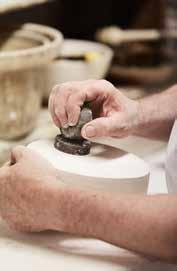
5 minute read
How We Make Burleigh
All our wares are made by hand in Stoke-on-Trent, England, using traditional techniques passed down through generations of skilled craftspeople. These are just some of our processes.
Slip House
Advertisement
Our clay is made to a unique recipe containing ball clay and china clay. The high proportion of china clay gives our ware strength, and its soft white hue. It arrives as flat blocks called ‘cake’ and either gets broken and fed into the pug mill to create cylinders of clay for plates and bowls, or heads to a tank where it becomes liquid clay called ‘slip’ for casting.
Mould Making
Our ware is formed with a mould, either by slip casting or by combining a mould with a profile tool. We keep an archive of ‘block moulds’ (our originals) which we cast fresh plaster onto to form the working moulds which shape our ware.
Casting Moulds
are filled with slip and left for the plaster body of the mould to evenly suck water from the slip, leaving a uniform skin coating the inside of the mould cavity. The time this takes is judged our expect casters, to create the perfect thickness.The excess slip in the mould is then tipped out and the cast left to firm up before it is unpacked.
Fettling and Sponging
Once our cast ware is dry, it’s ‘fettled and sponged’ to ensure a smooth finish to our products. ‘Fettling’ is the process of trimming back seams in the clay created by joins in the plaster moulds. Once all seams are trimmed, our Spongers smooth all the surfaces. Large Bowl Making Large bowls are made on a traditional piece of equipment called a ‘jigger-jolley’. This machine rotates a large mould beneath a shaping tool. The shaping tool is manually raised and lowered with one hand, whilst the other hand sponges the surface smooth. The foot is then sealed by hand by throwing the clay back onto itself.
Flatware Making
‘Flatware’ refers to plates and shallow bowls; each made from pugged clay. The cylinders of pugged clay are cut into slices which are then flattened like a pancake. This process is called ‘batting out’. This thin piece of clay is then thrown onto a mould attached to a rotating head. As the mould head rotates, a profile tool lowers and turns the shape of the plate back into the clay.
Towing
Before our plates are fired, the edges are smoothed in a process known as ‘towing’. Towing finishes the plate edge, allowing glaze to flow evenly over the surface. This process is very delicate as the plates are very fragile before firing.
Handling
We attach most of our handles by hand, casting them separately to the body of the cup. These individual handles are trimmed using a cutter to give them a perfect fit to our different shapes and precisely attached using sticky slip. The excess sticky slip is then sponged away with a lollipop sponge to leave a seamless finish.
Biscuit Firing
When dried, our ware’s ready for its first firing; called biscuit or ‘bisque’ firing. Each piece is carefully placed onto a Kiln Car sat on rails like train tracks, standing over 2 metres tall. The kiln reaches over 1100°C to create ‘biscuit ware’ and can take up to 48 hours to cool.
Biscuit Selection
During biscuit selection, our freshly fired biscuit ware is thoroughly checked for imperfections. First the appearance of the shape is checked, then the pieces are gently struck together; the sound produced determining structural integrity. Finally, each piece is firmly brushed to ensure an even surface ready for decoration.
Tissue Printing
Our unique decorating process begins with printing our patterns from an engraved copper cylinder or ‘roller’. These rollers are warmed through and coated with ink; fine tissue paper is thread through the machine, pressed against the roller, and prints in one continuous stream.
Tissue Transfer
Our skilled decorators size up these lengths of printed tissue against the item of ware to be decorated. Pieces of printed tissue are then cut by eye to fit each section of the shape. The edge of the tissue is then pressed onto the ware, the tack of the ink securing it in place. The rest of the tissue is then teased around the curves of the rest of the shape; the transferer will pinch and wrap the tissue to ensure a snug fit to the biscuit ware.
Rubbing
Our printed patterns are then secured in place by rubbing the back of the tissue with small pieces of flannel to ensure it is in position. A stiff nylon brush, called a stumper, is dipped into soft soap and forcefully rubbed onto the tissued surface. Our tissue paper is specially made to be strong when wet so, as long as the technique of rubbing is correct, the pattern stays intact.
Glazing
Once our patterns have been firmly fired onto the ware, they’re split into two tracks for either dipping or spraying. During dipping, each piece of holloware (teacups, jugs, bowls) is fully submerged in liquid glaze by hand, twisted and pulled out; with any excess glaze removed with a deft shake of the wrist.
Glost Firing
The items are loaded back on to the Kiln Car again. This final firing takes each piece over 1000°C. The kiln gradually builds in temperature until the thin coatings of glaze melt and combine forming a thin glossy layer, much like glass.
Glost Selecting
Whilst our ware is quality checked by our craftsmen on its journey through the factory, we can’t count our pots until they have passed the eagle eyes of our Glost Selectors. Using sight, touch and sound, they work as a team to check every piece is up to our Burleigh quality.





